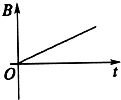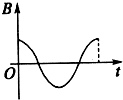问题
多选题
磁场的磁感应强度B随时间t变化的四种情况如图所示,能产生电磁波的是( )
A.
B.
C.
D.
答案
A、大小不变的磁场的周围不产生电场,所以不可能产生电磁波.故A错误;
B、快速振荡的磁场的周围产生快速振荡的电场,快速振荡的电场又能够产生快速振荡的磁场;所以BD选项的磁场能够产生电磁波.故B、D正确;
C、变化均匀的磁场周围产生稳定的电场,而稳定的电场不再产生磁场,所以不可能产生电磁波.故C错误.
故选:BD
